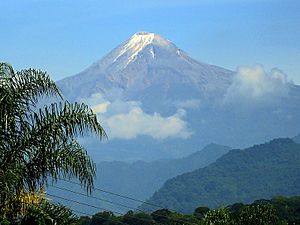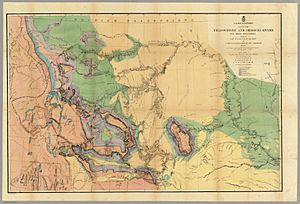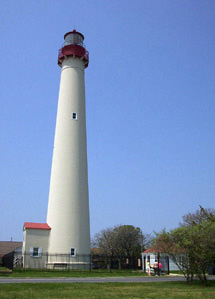William F. Raynolds facts for kids
Quick facts for kids
William F. Raynolds
|
|
|---|---|
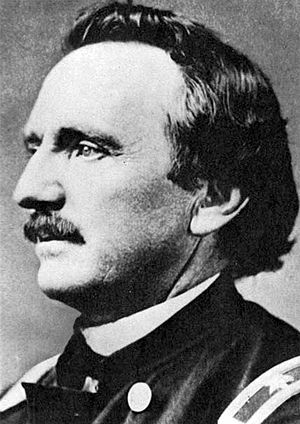 |
|
| Birth name | William Franklin Raynolds |
| Born | March 17, 1820 Canton, Ohio, U.S. |
| Died | October 18, 1894 (aged 74) Detroit, Michigan, U.S. |
| Allegiance | |
| Service/ |
|
| Years of service | 1843–1884 |
| Rank | |
| Unit | Corps of Engineers Corps of Topographical Engineers |
| Battles/wars | Mexican–American War American Civil War |
William Franklin Raynolds (born March 17, 1820 – died October 18, 1894) was an American explorer, engineer, and army officer. He served in the Mexican–American War and the American Civil War. He is best known for leading the Raynolds Expedition in 1859–60. This was an important journey to explore parts of the American West.
Raynolds was also a skilled engineer. He worked on many projects, like building lighthouses and improving rivers for ships. He helped map islands and shorelines on the Great Lakes. Several lighthouses he helped build are still standing today. Some are even listed as historic places.
In 1848, after the Mexican–American War, Raynolds and other U.S. Army members were the first to reach the top of Pico de Orizaba. This is the tallest mountain in Mexico. In 1859, he led the first government trip into the upper Yellowstone River area. This area later became Yellowstone National Park. Deep winter snows stopped his team from reaching the main Yellowstone Plateau. They had to go south instead, crossing Union Pass. After that, they explored Jackson Hole and the Teton Mountains. This area is now Grand Teton National Park.
During the Civil War, Raynolds fought in the Battle of Cross Keys in 1862. A year later, he was in charge of protecting the military base at Harpers Ferry, West Virginia. In 1865, he was given the honorary rank of brigadier general for his excellent service. After the war, he continued his engineering work. He retired from the army in 1884 as a colonel.
Contents
Early Life and Education
William Franklin Raynolds was born on March 17, 1820, in Canton, Ohio. He was one of six children. His grandfather, also named William Raynolds, was a soldier in the War of 1812.
William F. Raynolds went to the United States Military Academy at West Point, New York. He started there on July 1, 1839. He was a very good student, graduating fifth in his class in 1843. Some of his classmates became famous, including future President Ulysses S. Grant. Raynolds married when he was young, but he and his wife did not have children.
Military Career and Explorations
Early Engineering Work
After graduating from West Point, Raynolds joined the U.S. Army Corps of Topographical Engineers. This group surveyed land and made maps for the army. In 1863, they joined with the main United States Army Corps of Engineers. Raynolds's first jobs were improving navigation on the Ohio River. He also helped survey the border between the U.S. and Canada.
Climbing Mexico's Tallest Mountain
During the Mexican–American War, Raynolds served with General Winfield Scott. After the war, the American army occupied Mexico City. Raynolds and others decided to explore the nearby mountains. They became the first confirmed climbers to reach the top of Pico de Orizaba. This mountain is 18,620 feet (5,680 m) tall.
Raynolds's team used special tools like grappling hooks and spiked shoes to help them climb. Local villagers told them it was impossible, but the Americans were determined. On May 10, 1848, Raynolds and a few others reached the summit. This climb might have set an American record for high-altitude climbing that lasted 50 years! Raynolds thought Pico de Orizaba was the tallest mountain in North America at the time.
Building Lighthouses
After returning from Mexico, Raynolds continued mapping the U.S.–Canada border. He also worked on getting water for Washington, D.C. He spent several years mapping shorelines on the Great Lakes. He looked for good places to build lighthouses.
In 1857, he was put in charge of designing and building lighthouses along the Jersey Shore and the Delmarva Peninsula. He oversaw the building of the Fenwick Island Light in Delaware and the Cape May Lighthouse in New Jersey. In 1859, he was finishing the Jupiter Inlet Light in Jupiter, Florida. Then, he got a new assignment: to lead an expedition to the Yellowstone region.
The Raynolds Expedition
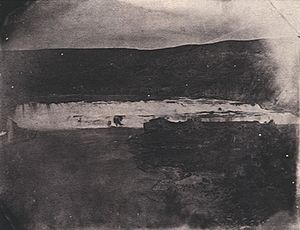
In 1859, Raynolds was chosen to lead an expedition to the Yellowstone area in Montana and Wyoming. The goal was to learn about the land, its resources, and the Native American tribes living there. The team included a photographer, a mapmaker, and a geologist named Ferdinand Vandeveer Hayden. Famous mountain man Jim Bridger was hired as their guide.
The expedition started in May 1859 from St. Louis, Missouri. They traveled up the Missouri River by steamboat. Then, they went overland, meeting the Crow Indians. Raynolds was impressed by the Crow chief and traded horses with them.
Raynolds split his team for a while. One group explored the Tongue River. Two members of this group were the first people of European descent to reach a unique rock formation. This place is now known as Devils Tower. By October 1859, the groups reunited and spent the winter in central Wyoming.
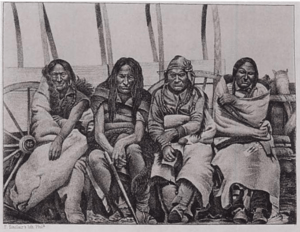
The expedition continued in May 1860. Raynolds tried to cross the mountains at Togwotee Pass. However, deep snow and cliffs stopped them. Jim Bridger then led them south over another pass, which Raynolds named Union Pass. From there, they entered Jackson Hole and saw the Teton Mountains.
Even though they couldn't reach the main Yellowstone area, the Raynolds Expedition was important. It was the first government-funded group to explore Jackson Hole and the Teton Range. They traveled over 2,500 miles (4,000 km) and explored a huge area. Raynolds also noted that bison were being killed too quickly. His full report on the expedition was delayed until 1868 because of the Civil War.
American Civil War Service
When the Civil War began, Raynolds returned to Washington, D.C. He became the chief engineer for the Department of Virginia. He and his team made important maps of Virginia and what would become West Virginia. In 1862, he was part of John C. Frémont's chase after Stonewall Jackson. He also fought in the Battle of Cross Keys.
After recovering from an illness, Raynolds was put in charge of defending Harpers Ferry, West Virginia in 1863. This was during Robert E. Lee's second invasion of the North. On March 31, 1863, the Topographical Engineers joined the main Corps of Engineers. Raynolds stayed in this branch for the rest of his career.
In 1864, Raynolds returned to the Great Lakes area to work on surveys and lighthouses. He did not see any more combat. On March 13, 1865, he was given the honorary rank of brigadier general for his excellent service during the war.
After the War
After the Civil War, Raynolds continued his engineering work. He oversaw projects to improve rivers like the Arkansas, Mississippi, and Missouri Rivers. He also helped with harbor improvements in places like Buffalo, New York, and Erie, Pennsylvania.
From 1864 to 1870, Raynolds was the main engineer for lighthouses in the Great Lakes area. He oversaw the building of many lighthouses there. He was promoted to lieutenant colonel in 1867 and then to colonel in 1881. He also managed the building of the Hereford Inlet Lighthouse in New Jersey in 1874.
Raynolds retired from the army on March 17, 1884, after 40 years of service. He died on October 18, 1894, in Detroit, Michigan. He was buried in West Lawn Cemetery in Canton, Ohio.
Legacy and Impact
Raynolds's climb of Pico de Orizaba in 1848 was a very early example of serious mountaineering. It showed great planning and use of early climbing tools.
Even though the Raynolds Expedition didn't reach the center of Yellowstone, its maps were very useful for later explorers. Raynolds also found good routes for wagons and helped figure out the best paths for a future transcontinental railroad. He also discovered that most rivers in the region were too rough for steamboats. Many lighthouses he helped design or build are still standing and are important historic sites.
Two places are named after William Raynolds. Raynolds Pass is a mountain gap where his expedition crossed the Continental Divide. Raynolds Peak is a mountain in the Teton Range named after him in 1938. Also, a fossil snail, Viviparus raynoldsanus, was named in his honor by Ferdinand V. Hayden.
Lt. Col. William F. Raynolds is also known as the first Commander of the St. Louis Engineer Office for the U.S. Army Corps of Engineers.
See also
 In Spanish: William F. Raynolds para niños
In Spanish: William F. Raynolds para niños


